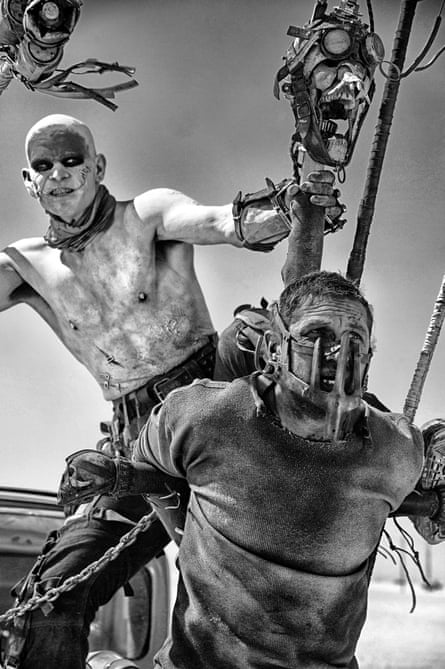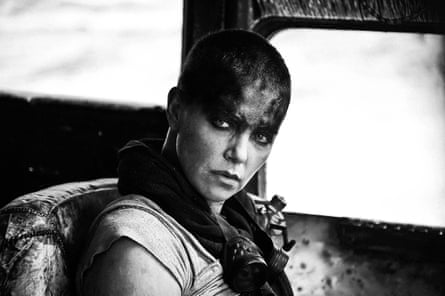Ted Kotcheff, the director of Wake in Fright, recently told me how he was inspired by what the German philosopher Gottfried Leibniz called “petite perceptions”. Before rolling the camera on his 1971 masterpiece, Kotcheff purchased thousands of dead flies from Sydney university, spread them everywhere on set (on top of books, on the ground, on shelves and tables), and sprayed the air with a fine dust-like substance.
You can’t see these things on screen but, he argued, they have a psychological impact.
George Miller relishes this sort of approach to film-making. The dystopian Mad Max universe, with its visions of a junkyard future comprised of the flotsam and jetsam of human civilisation, is full of recycled commodities: what the director calls “found objects repurposed”. And thus the perfect sandbox for Leibnizian alternate worlds etched out in small details.
Few viewers of Mad Max: Fury Road would be aware, for instance, that there is a subtle bird theme running through the design and makeup of The Valkyrie, a Warrior Woman-esque character played by Megan Gale. Fewer still would know an illustration of a bird was carved on to the handle of her gun, a stainless steel Winchester rifle. You can’t see it on screen but, again, it’s there and in some way makes a difference.
Nobody can say precisely what effect monochrome photography has on petite perceptions; the extent to which it makes certain things even harder to notice. Especially in the rare instance of a production that was originally in colour. And by George (Miller, as the case may be), such re-stylisation throws a spanner in works when it comes to contemplating how a film’s visual tone informs overall psychological impact.
I was one of many Mad Max super-fans who, over the weekend, returned to see Fury Road on the big screen – this time in a rejigged colour-drained Black & Chrome edition that is out now on DVD and Blu-ray in a special two-disc set (which includes the original version).

The director has spoken about how he has always wanted to release a Mad Max movie in black and white, and considers this the best version. I suspect you’ll be hard-pressed to find somebody who agrees with him, given the rousing burnt orange look of the original. But it is unquestionably a fascinating way to re-evaluate the greatest action film of the new millennium.
On the Fury Road PR circuit Miller observed, with a touch of bemusement, how the reception to Fury Road demonstrated a strange compulsion in audiences: that they can become nostalgic for the apocalypse.
In a sense Black & Chrome is a weird extension of that thinking. It feels like the film itself has become nostalgic for the film itself. Or, as I prefer to think of it, that somebody separate from the narrative has got their hands on Fury Road and changed the perspective from which we view it.
In real life that person is obviously Miller but it’s more fun to think of them as a character linked to this universe. Perhaps somebody older who is recalling the story. The misty black-and-white surface is, then, a reflection of that. I was reminded of words familiar to Mad Max aficionados: “My life fades. The vision dims. All that remains are memories.”
Those are spoken by an elderly person narrating the opening sequence of 1981’s Mad Max 2: The Road Warrior, which contains black-and-white graded footage from the original movie, in a faux documentary reel. We eventually learn, at the end of the story, that the narrator is one of the characters (the Feral Kid) nearing the end of his life. The entire film is him replaying memories of his formative years. Of how, “in this blighted place, he learned to live again”.
Miller and his production designer, the now-Oscar-winning Colin Gibson, filled out the universe of Fury Road with the ethos that just because the setting is a hell-in-a-handbasket wasteland does not mean it can’t have things of beauty. A few of these manifested as pocket-sized doodads in the possession of The Keeper of the Seeds (Melissa Jaffer), including a sprig of green leaves. That green looked radiant, contrasted against an acid blue night sky.

That is, before Miller came and smoked it all away. In Black & Chrome these fleeting morsels of beauty have been all but eradicated; there is literally no colour left. Same goes, of course, for grander aesthetic things, like the mighty mustard brown sand dunes of Namibia, which broke up the landscape like bumpy breasts from God. There’s no question the special effects, many of which involve fireballs and explosions, have lost a little of their lustre.
And yet, something enthralling and anachronistic has been added to the pot: Fury Road now a time capsule for a past that never happened. Miller has swapped out the beauty of detail with a broader, all-pervading sense of style, which gives us reason to evaluate it anew. As life fades and the vision dims, those petite perceptions seem to get smaller and smaller.
